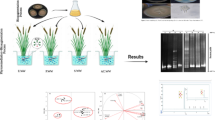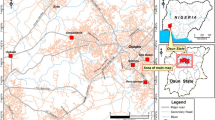Abstract
The excessive use of pretilachlor (a chloroacetamide herbicide) has raised concern throughout the world as it has been reported as highly toxic. The present study deals with isolating and screening pretilachlor degrading fungal strains. The strains Aspergillus ficuum (AJN2) and Aspergillus sp. (PDF1) isolated using enrichment technique were able to degrade 79% and 73% of pretilachlor respectively as analyzed using HPLC. Further, the immobilization technique was used in the study the pretilachlor degradation ability of the isolated strains. The immobilized spores of the strains AJN2 and PDF1 mineralized 84% and 95% of pretilachlor respectively. The degradation dynamics study revealed that the DT50 value of the herbicide was reduced to 2.4 d in aqueous medium due to the enhanced enzymatic activity. The enzymatic study showed high lignin peroxidase and manganese peroxidase activity by the strains AJN2 and PDF1 respectively. The study confirmed the efficient degradation of pretilachlor by Aspergillus ficuum (AJN2).












Similar content being viewed by others
Data availability
The data used to support the findings of the study are included within the article.
References
Abraham J, Mukherjee P, Bose D, Dutta A (2016) Utilization of monocrotophos by Aspergillus sojae strain JPDA1 isolated from sugarcane fields of Vellore district in India. Res J Pharm Technol 9:1451–1456
Abraham J, Silambarasan S, Logeswari P (2014) Simultaneous degradation of organophosphorus and organochlorine pesticides by bacterial consortium. J Taiwan Inst Chem Eng 45:2590–2596
Agarwal A, Prajapati R, Singh OP et al (2015) Pesticide residue in water—A challenging task in India. Environ Monit Assess 187:1–21
Bhardwaj A, Singh J, Chaman S (2018) Molecular characterization of native dairy wastewater degrading microbes isolated from dairy industry effluent. Nat Environ Pollut Technol 17:517–523
Bhatt P (2019) Smart bioremediation technologies: microbial enzymes. Academic Press
Chatterjee A, Abraham J (2019) Mycoremediation of 17 β-estradiol using Trichoderma citrinoviride strain AJAC3 along with enzyme studies. Environ Prog Sustain Energy 38:13142
Gajendiran A, Abraham J (2017) Biomineralisation of fipronil and its major metabolite, fipronil sulfone, by Aspergillus glaucus strain AJAG1 with enzymes studies and bioformulation. 3 Biotech 7:1–15
Gardes M, Bruns TD (1993) ITS primers with enhanced specificity for basidiomycetes-application to the identification of mycorrhizae and rusts. Mol Ecol 2:113–118
Hou Y, Dong W, Wang F et al (2014) Degradation of acetochlor by a bacterial consortium of Rhodococcus sp. T3–1, Delftia sp. T3–6 and Sphingobium sp. MEA3-1. Lett Appl Microbiol 59:35–42
Huang Y, Zhan H, Bhatt P, Chen S (2019) Paraquat degradation from contaminated environments: current achievements and perspectives. Front Microbiol 10:1754
Jiang J, Chen Y, Yu R et al (2016) Pretilachlor has the potential to induce endocrine disruption, oxidative stress, apoptosis and immunotoxicity during zebrafish embryo development. Environ Toxicol Pharmacol 42:125–134
Kaur P, Kaur P, Duhan A, Bhullar MS (2017) Effect of long-term application of pretilachlor on its persistence and residues in paddy crop. Environ Technol 38:2410–2415
Labeda DP, Goodfellow M, Brown R et al (2012) Phylogenetic study of the species within the family Streptomycetaceae. Antonie Van Leeuwenhoek 101:73–104
Liu J, Zhang X, Xu J et al (2020) Anaerobic biodegradation of acetochlor by acclimated sludge and its anaerobic catabolic pathway. Sci Total Environ 748:141122
Liu H, Yuan M, Liu A et al (2021) A bifunctional enzyme belonging to cytochrome P450 family involved in the O-dealkylation and N-dealkoxymethylation toward chloroacetanilide herbicides in Rhodococcus sp. B2. Microb Cell Fact 20:1–13
Pereira CAA, Nava MR, Walter JB et al (2021) Application of zero valent iron (ZVI) immobilized in Ca-Alginate beads for CI Reactive Red 195 catalytic degradation in an air lift reactor operated with ozone. J Hazard Mater 401:123275
RajaRajeswari R, Sathiyanarayanan S, Ramesh A, Ayyappan S (2013) Evaluation of bioavailability of residues of pretilachlor in soil and water under paddy cropping condition and their In! uence on Lemna gibba. J Agric Environ 14:102–110
Saha S, Yaduraju NT, Kulshrestha G (2003) Residue studies and efficacy of sulfosulfuron in wheat crop. Pestic Res J 15:173–175
Shilpakar O, Karki B, Rajbhandari B (2020) Pretilachlor poisoning: a rare case of a herbicide masquerading as organophosphate toxicity. Clin Case Rep 8:3506–3508
Teramoto K, Sato H, Sun L et al (2007) Phylogenetic classification of Pseudomonas putida strains by MALDI-MS using ribosomal subunit proteins as biomarkers. Anal Chem 79:8712–8719
Wei J, Feng Y, Sun X et al (2011) Effectiveness and pathways of electrochemical degradation of pretilachlor herbicides. J Hazard Mater 189:84–91
Worthing CR, Hance RJ (1991) Pretilachlor. Pestic manual, 9th edn Br Crop Prot Counc Surrey 699
Acknowledgements
The authors would like to express their gratitude to the management of Vellore Institute of Technology, Vellore.
Funding
The authors declare that no funds, grants or other support were received during the preparation of the manuscript.
Author information
Authors and Affiliations
Contributions
JA contributed to the study conception and design. Material preparation, data collection and analysis were performed by NK. The manuscript was prepared by NK and JA.
Corresponding author
Ethics declarations
Conflict of interest
The authors have no conflict of interest to declare.
Additional information
Communicated by Yusuf Akhter.
Publisher's Note
Springer Nature remains neutral with regard to jurisdictional claims in published maps and institutional affiliations.
Rights and permissions
Springer Nature or its licensor (e.g. a society or other partner) holds exclusive rights to this article under a publishing agreement with the author(s) or other rightsholder(s); author self-archiving of the accepted manuscript version of this article is solely governed by the terms of such publishing agreement and applicable law.
About this article
Cite this article
Kwatra, N., Abraham, J. Biomineralization of pretilachlor by free and immobilized fungal strains isolated from paddy field. Arch Microbiol 205, 188 (2023). https://doi.org/10.1007/s00203-023-03538-4
Received:
Accepted:
Published:
DOI: https://doi.org/10.1007/s00203-023-03538-4




